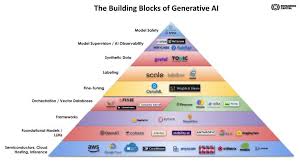White Paper: Generative AI on Google Cloud with LangChain
Executive Summary
The rapid advancement of generative AI has transformed industries by enabling the creation of human-like text, realistic images, and even complex data-driven decisions. Leveraging Google Cloud's robust infrastructure combined with the LangChain framework, businesses can unlock new possibilities in artificial intelligence applications. This white paper explores the integration of generative AI with LangChain on Google Cloud, its architecture, and real-world use cases across various domains.
Introduction
Google Cloud provides a powerful and scalable infrastructure to support AI workloads, including pre-trained models, machine learning (ML) services, and serverless computing. LangChain, on the other hand, is a popular framework designed to connect language models with external data, tools, and APIs, enabling the development of advanced AI agents and applications.
By combining the capabilities of Google Cloud with LangChain, organizations can:
- Streamline the development of generative AI applications.
- Reduce latency in processing and responding to queries.
- Scale resources dynamically based on workloads.
- Enhance security and compliance for sensitive data.
Architecture Overview
Key Components:
- Google Cloud AI & ML Services:
- Vertex AI for training and deploying ML models.
- BigQuery for managing and querying large datasets.
- Cloud Functions and Cloud Run for serverless execution.
- LangChain Framework:
- Supports integrations with OpenAI, Anthropic, and Google’s PaLM API.
- Offers modular components such as prompt templates, memory management, and tools for retrieval-augmented generation (RAG).
- Vector Databases:
- Integration with Google’s Firestore or third-party vector databases for efficient data retrieval.
- Security and Compliance:
- Data encryption with Google Cloud’s Key Management Service (KMS).
- Role-based access control (RBAC) for secure workflows.
Flow Diagram
Below is a high-level flow diagram illustrating the interaction between LangChain and Google Cloud components:
graph LR subgraph LangChain Framework A[Prompt Templates] --> B[Memory Management] B --> C[RAG Tools] end subgraph Google Cloud Infrastructure D[Vertex AI] --> E[Cloud Functions] F[BigQuery] --> G[Firestore] G --> H[Cloud Run] end A --> D C --> F H --> E
Use Cases
1. Customer Support Automation
- Problem: Businesses often face high volumes of repetitive customer queries, leading to inefficiencies.
- Solution:
- Use LangChain with Google Cloud's PaLM API to build AI agents that provide contextual responses to customer queries.
- Deploy the agent on Cloud Run for scalability.
- Integrate BigQuery to analyze customer feedback and improve responses.
- Benefits: Reduced operational costs and improved customer satisfaction.
2. E-commerce Product Recommendations
- Problem: Personalizing product recommendations at scale can be resource-intensive.
- Solution:
- Combine LangChain's RAG capabilities with Google Cloud’s AI models to create a recommendation engine.
- Use Firestore to store user preferences and browsing data.
- Benefits: Enhanced customer engagement and higher conversion rates.
3. Financial Data Analysis
- Problem: Processing large financial datasets and generating insights is time-consuming.
- Solution:
- Leverage LangChain to create an AI-powered assistant for financial analysis.
- Use BigQuery ML for predictive analytics.
- Integrate the solution with Google Sheets for seamless collaboration.
- Benefits: Faster decision-making and improved financial forecasting.
4. Healthcare Chatbots
- Problem: Patients often require quick answers to health-related questions.
- Solution:
- Use LangChain to design HIPAA-compliant conversational agents.
- Host the solution on Google Cloud’s Vertex AI for robust performance.
- Integrate with secure healthcare databases for personalized responses.
- Benefits: Enhanced patient experience and reduced workload for medical staff.
5. Education and Training
- Problem: Designing personalized learning paths for students is challenging.
- Solution:
- Use LangChain’s dynamic memory and Google Cloud's ML services to create interactive learning platforms.
- Integrate with Firebase for real-time collaboration and progress tracking.
- Benefits: Improved learning outcomes and student engagement.
Implementation Best Practices
- Optimize for Cost:
- Use serverless options like Cloud Functions for lightweight tasks.
- Monitor resource usage with Google Cloud Monitoring.
- Ensure Data Security:
- Encrypt sensitive data at rest and in transit.
- Regularly audit access logs and permissions.
- Iterate and Improve:
- Use A/B testing to optimize AI models.
- Gather user feedback to refine generative outputs.
- Leverage Hybrid Solutions:
- Combine Google Cloud services with on-premise solutions for hybrid architectures.
- Use Anthos for seamless management across environments.
Conclusion
The integration of Google Cloud and LangChain offers a compelling solution for businesses looking to harness the power of generative AI. By leveraging scalable infrastructure, robust security features, and advanced AI frameworks, organizations can deliver innovative applications across industries. With the right implementation strategy, generative AI can drive efficiency, improve user experiences, and unlock new revenue streams.
References
- Google Cloud Documentation: https://cloud.google.com
- LangChain Framework: https://langchain.com
- Vertex AI Overview: https://cloud.google.com/vertex-ai
- Retrieval-Augmented Generation: https://langchain.com/docs/use-cases/rag
- Security Best Practices: https://cloud.google.com/security



